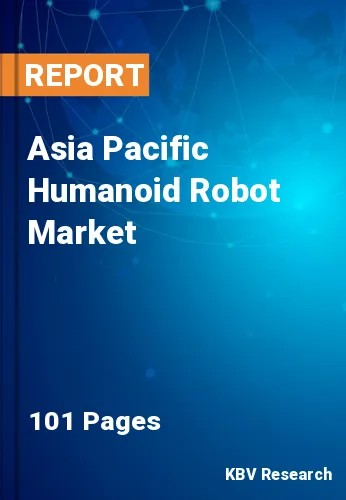
The Asia Pacific Humanoid Robot Market would witness market growth of 54.0% CAGR during the forecast period (2023-2030).
Humanoid robots have been long-awaited, but they have now started to show potential in an array of applications. The market is experiencing several developments. The creations of Sophia, Ameca, HERMES, and other well-known humanoid robots are only a few. Sophia, a humanoid robot that made her debut in 2016, was constructed by the Hong Kong-based Hanson Robotics business and meant to resemble Audrey Hepburn, a well-known Hollywood actress, to use her as a crowd controller at events or an elderly companion in nursing homes.
Ameca, a humanoid robot that Engineered Arts produced in 2021, is the most sophisticated and realistic. On December 1, 2021, Ameca publicly debuted her first video, which was well-received on Twitter and TikTok. It is primarily meant to be a platform for developing human-robot interaction technologies in robotics. To communicate with the public, AMECA uses facial recognition software, a chest camera, binocular eye-mounted cameras, embedded microphones, and other technology. Interactions may be managed by GPT-3 or by telepresence from a human. Modern technology created prosthetic ligaments, limbs, and sensor arrays.
Robotics technology may be adopted more quickly due to China's research and development (R&D) activities. The production of medical robots is one of the key objectives of the 14th Five-Year Plan (2021–2025), which aims to hasten information technology's integration into the medical equipment industry. The approach makes funding for R&D projects involving robotics more possible. Innovations in local MedTech will be encouraged by the "Made in China 2025" strategy, which also includes high-performance medical equipment areas for development, and the domestic market share for surgical robotics will grow. These elements are anticipated to encourage the regional market's expansion.
The China market dominated the Asia Pacific Humanoid Robot Market by Country in 2022, and would continue to be a dominant market till 2030; thereby, achieving a market value of $3,510.4 Million by 2030. The Japan market is experiencing a CAGR of 52.1% during (2023 - 2030). Additionally, The India market would exhibit a CAGR of 54% during (2023 - 2030).
Based on Component, the market is segmented into Hardware and Software. Based on Application, the market is segmented into Personal Assistance & Caregiving, Hospitality, Research & Space Exploration, Education & Entertainment, Search & Rescue and Others. Based on Motion Type, the market is segmented into Wheel drive and Biped. Based on countries, the market is segmented into China, Japan, India, South Korea, Singapore, Malaysia, and Rest of Asia Pacific.
Free Valuable Insights: The Worldwide Humanoid Robot Market is Projected to reach USD 39.6 Billion by 2030, at a CAGR of 52.8%
The market research report covers the analysis of key stake holders of the market. Key companies profiled in the report include Hajime Research Institute, Ltd., Hanson Robotics Limited, Honda Motor Co. Ltd., HYULIM Robot Co., Ltd., KAWADA Robotics Corporation (Kawada Technologies Co., Ltd.), PAL ROBOTICS, SoftBank Robotics Group (SoftBank Group Corporation), Toshiba Corporation, Toyota Motor Corporation and Trossen Robotics.
By Component
By Application
By Motion Type
By Country
Our team of dedicated experts can provide you with attractive expansion opportunities for your business.
